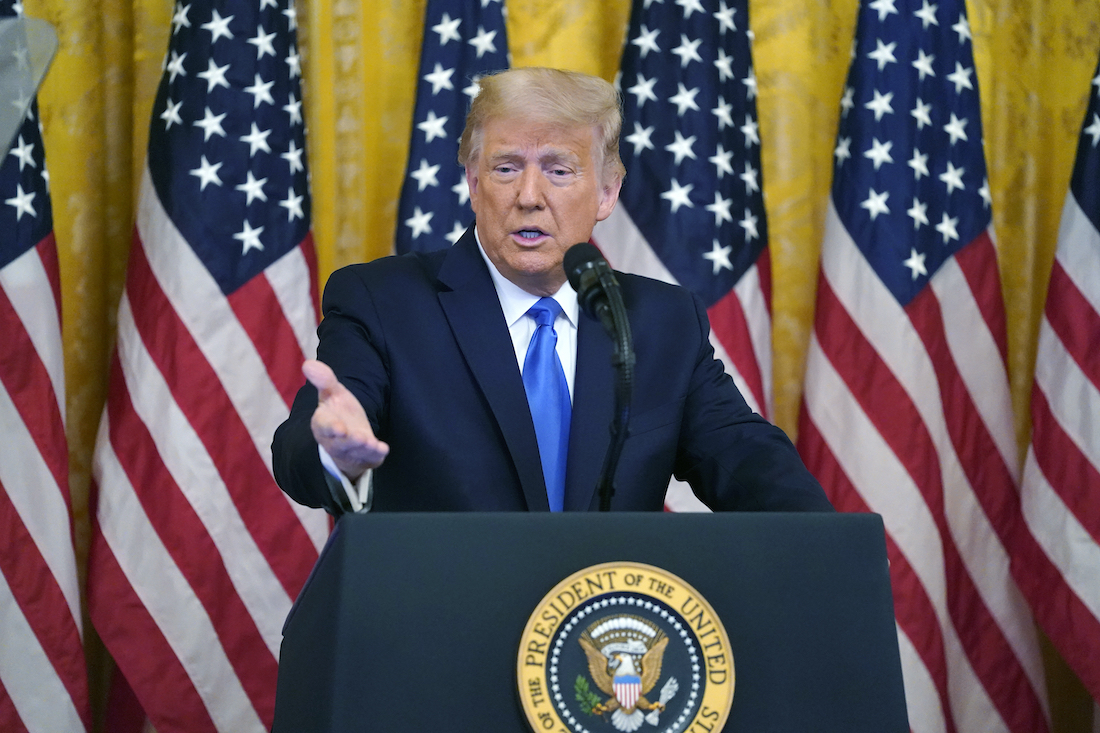President Donald Trump has decided to fill the vacant Supreme Court seat left by the death of Justice Ruth Bader Ginsburg just weeks before the 2020 election. Does he have the legal and constitutional power to do so? What if he loses the election? What have other presidents done? And what about the “Biden” or “Thurmond” Rule? Here are the facts you need to know.
Does the president have the power to appoint a Supreme Court justice in his final year?
The president retains his full constitutional powers until the moment he leaves office. The Appointments Clause (Article II, Section 2) of the U.S. Constitution says the president “shall nominate, and by and with the Advice and Consent of the Senate, shall appoint … Judges of the supreme Court.”
Is it common for a Supreme Court justice to be nominated or confirmed during the final year of a president’s term?
Presidents have nominated a candidate to the Supreme Court 31 times during an election year or after an election but before the inauguration. Presidents acted 29 times to fill an existing Supreme Court seat. According to The Washington Post, “one-third of all presidents have appointed a Supreme Court justice in an election year.”
Can a Supreme Court justice be confirmed during a lame-duck session?
Yes; several have been. (See the next question.) However, the vote count and political calculus could change markedly. In addition to general public backlash against outgoing politicians making major decisions, Senate Republicans’ 53-47 majority may be threatened. Two Republicans, Susan Collins and Lisa Murkowski, have said they will not vote on a Supreme Court justice before the election. That still leaves the GOP enough votes to proceed to a vote. However, if Mark Kelly defeats appointed Senator Martha McSally of Arizona, state law dictates that “the person elected shall fill the remaining unexpired term of the vacated office.” Kelly could be sworn in by November 30 and take part in the lame-duck session. The new Senate will be sworn in on January 3, 2021, and the Senate could act until Trump leaves office on January 20. Vice President Mike Pence could break a 50-50 tie.
Can the president appoint a Supreme Court justice if he loses the election?
Yes. A total of five U.S. Supreme Court justices have been confirmed after a presidential election by a lame-duck president who lost the election (Adams, Van Buren, Benjamin Harrison) or did not run (Washington, Tyler). Four additional outgoing, lame-duck presidents tried unsuccessfully to place their nominees on the Supreme Court between the election and the inauguration (J.Q. Adams, Filmore, Hayes, Buchanan). Rutherford B. Hayes nominated Stanley Matthews to the bench three month after James A. Garfield won the 1880 presidential election, but the Senate took no action. Garfield renominated Matthews, who was subsequently confirmed by one vote – the slimmest margin in Supreme Court history.
Although he does not exactly fit the criteria, Justice Stephen Breyer began his ascent to the Supreme Court when President Jimmy Carter nominated him to the 1st U.S. Circuit Court of Appeals on November 13, 1980 – nine days after Carter lost a 44-state landslide to Ronald Reagan. The Senate confirmed Breyer on December 9, 1980.
Were any of these justices consequential to American jurisprudence?
The longest-serving Chief Justice in Supreme Court history, John Marshall, was nominated after John Adams lost the 1800 presidential election but before the House of Representatives broke the Electoral College tie between Thomas Jefferson and Aaron Burr. Marshall established the doctrine of judicial review – the legal notion that the Supreme Court has the power to decide whether a government action is constitutional – in Marbury v. Madison (1803). (Adams’ son, John Quincy Adams, would also nominate a justice after losing the 1828 election to Andrew Jackson, but the Senate did not vote on the matter.) But as part of the most elite legal fraternity in the judicial profession, all justices are consequential.
Which president nominated a justice to the Supreme Court latest in his term?
President Andrew Jackson nominated Justice John Catron to a new seat on the Supreme Court in March 3, 1837 – Jackson’s last full day in office and two days before Martin Van Buren’s inauguration. The Senate confirmed Catron five days after the nomination.
What is the “Biden Rule”? Does it prevent an election-year SCOTUS appointment?
The “Biden Rule” is not a formal Senate rule or norm. In a speech delivered on the Senate floor on June 25, 1992, then-Senator Biden responded to rumors that Justice Harry Blackmun’s retirement was imminent. Since confirmation hearings during the heat of an election would bring only “partisan bickering and political posturing from both parties,” Biden suggested that “if a Supreme Court Justice resigns tomorrow, or within the next several weeks, or resigns at the end of the summer, President Bush should consider following the practice of a majority of his predecessors and not – and not – name a nominee until after the November election is completed.” (As noted, this is not the norm.) If he did, “the Senate Judiciary Committee should seriously consider not scheduling confirmation hearings on the nomination until after the political campaign season is over,” presumably during the lame-duck session. In 2016, as Biden stumped for the confirmation of Merrick Garland, he said his words applied only to an “extreme candidate” (like Clarence Thomas), and the Biden rule “doesn’t exist.” And on September 20, 2020, Biden said that “Majority Leader [Mitch] McConnell made up” a “new rule, the McConnell rule,” which is “based on the fiction that I somehow believe there should be no nomination to the court in an election year. That’s ridiculous.” Its author apparently does not believe the Biden Rule is binding precedent.
What is the “Thurmond Rule”?
The Thurmond Rule is harder to pin down and less relevant. It is said to hold that judicial nominations to lower courts – and not the Supreme Court – should slow down after June, or March, of a presidential election year. In 1980, Sen. Strom Thurmond, R-S.C., reportedly advocated for Senate Republicans to delay President Carter’s judicial appointments; however, most of the nominees in question received a vote within a week and, as noted, the Senate confirmed Stephen Breyer in the lame-duck session. The rate of lower-court judicial confirmations in presidential elections fell dramatically following the bruising confirmation hearings of Judge Robert Bork (from 71% in 1984 to 44% in 1988). “The Thurmond rule neither is a rule nor can it be attributed to the late Senator Strom Thurmond,” said former Sen. Orrin Hatch. Then-Sen. Jeff Sessions said more forcefully: “It is a myth. It does not exist.”
Has an election-year Supreme Court appointment ever affected a presidential election?
In 1916, Woodrow Wilson appointed John Clarke to replace Charles Evans Hughes – who resigned to accept the Republican presidential nomination to challenge Wilson. (Wilson narrowly defeated Hughes. Herbert Hoover reappointed Hughes to the court as Chief Justice in 1930 – to replace former President and Chief Justice William Howard Taft.)
Can a president make a temporary “recess appointment” to the Supreme Court?
Yes. The president could appoint a recess appointment to the Supreme Court if the Senate goes into recess at least 10 days, under National Labor Relations Board v. Noel Canning (2014). The appointment could last no longer than the end of the next session without formal Senate confirmation. President Dwight Eisenhower made three recess appointments to the Supreme Court – Earl Warren, William Brennan, and Potter Stewart – all of whom were subsequently confirmed.
Is there enough time to confirm a justice to the Supreme Court before the election or the end of his term?
Since Robert Bork, a Supreme Court nominee has received a vote an average of 30 calendar days after his or her Senate confirmation hearings begin. There are 39 days between Monday, September 28, and election day. However, the average time between a Supreme Court justice’s nomination and confirmation is 76 calendar days (including recesses), making this a remarkably tight timeframe for a modern nominee. For more information, see, “Explainer: Is there enough time to confirm a Supreme Court nominee before the election?”
Would confirming a Supreme Court justice this close to a presidential election trigger a backlash?
Democrats have promised that. Sen. Chuck Schumer has said if Democrats take take the majority, “everything is on the table.” Sen. Ed Markey, D-Mass., suggested, “When Democrats control the Senate in the next Congress, we must abolish the filibuster and expand the Supreme Court.” Legal analyst Jeffrey Toobin also proposed retaliating by granting statehood to Washington, D.C., and Puerto Rico.
However, Democratic leaders had proposed all of these steps before there was a Supreme Court vacancy. During his speech at Congressman John Lewis’ funeral on July 30, former President Barack Obama encouraged his fellow Democrats to begin “ending the filibuster,” calling it a “Jim Crow relic”; and to grant “equal representation in our government” to Puerto Rico and Washington, D.C. Last June, Democratic presidential hopeful Pete Buttigieg proposed expanding the Supreme Court to 15 seats.
What factors should Senators consider when voting to confirm a Supreme Court nominee during an election year?
Senators confirming a nominee to the Supreme Court during an election year should consider the same criteria as they would during any confirmation hearing: Senators should judge a Supreme Court nominee by his or her fidelity to the U.S. Constitution as interpreted through the original intent of those who wrote its venerable text.
(Photo credit: Associated Press / Evan Vucci.)

